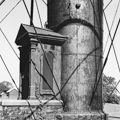The U.S. Coast Guard still operates this archaic-looking lighthouse, part of a historic network serving Delaware River ship traffic. River range lighthouses are rare today nationwide. The 120-foot tower was fabricated of wrought iron by Kellogg Bridge Company of Buffalo, New York, and originally stood a few miles east, where it was coated with a protective layer of coal tar and held a fixed white light. Dwellings, a barn, and an oil house were built to serve it on its current site, to which it was moved. It was electrified and automated in the 1930s and recorded by the Historic American Engineering Record in 1976. The lighthouse is unusual for being of wrought iron rather than cast iron. Raised on a stone base and with a narrow central column and a skirtlike array of stays radiating from the top, Liston bears a close resemblance to the later Reedy Island Range Rear Light, Taylors Bridge (1909–1910).
You are here
Liston Range Rear Lighthouse
If SAH Archipedia has been useful to you, please consider supporting it.
SAH Archipedia tells the story of the United States through its buildings, landscapes, and cities. This freely available resource empowers the public with authoritative knowledge that deepens their understanding and appreciation of the built environment. But the Society of Architectural Historians, which created SAH Archipedia with University of Virginia Press, needs your support to maintain the high-caliber research, writing, photography, cartography, editing, design, and programming that make SAH Archipedia a trusted online resource available to all who value the history of place, heritage tourism, and learning.











